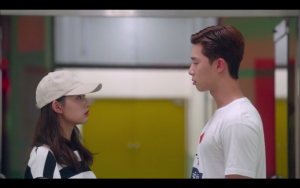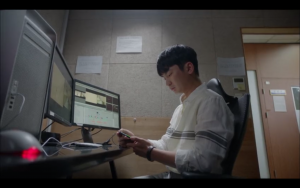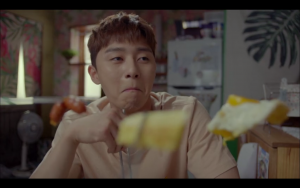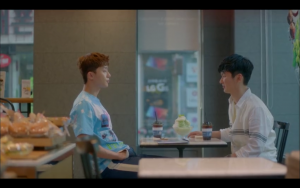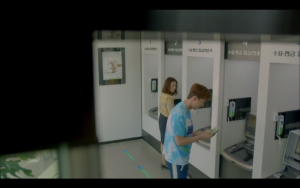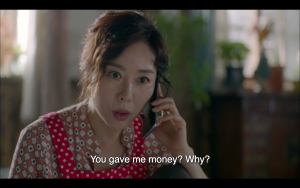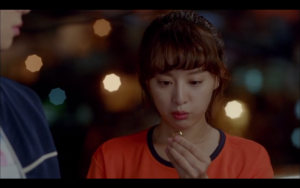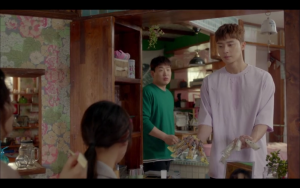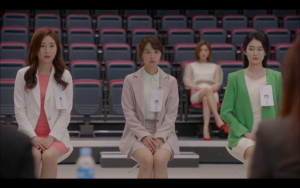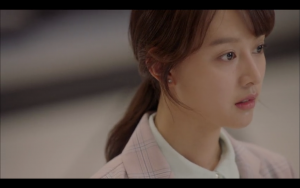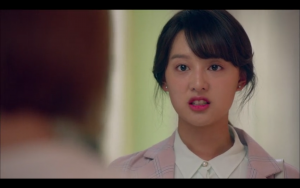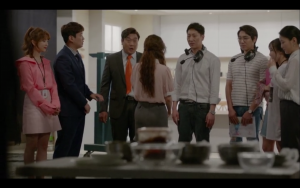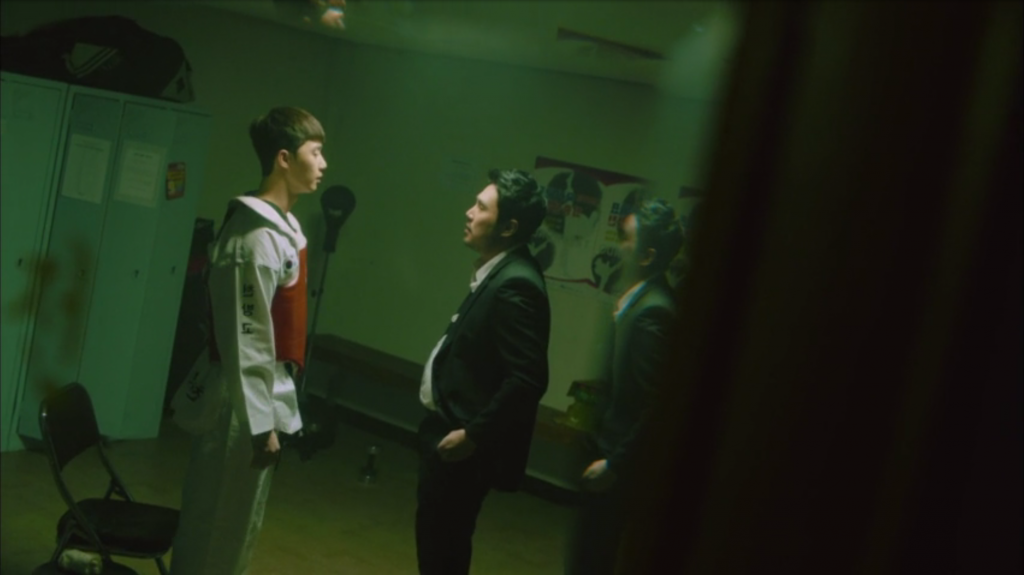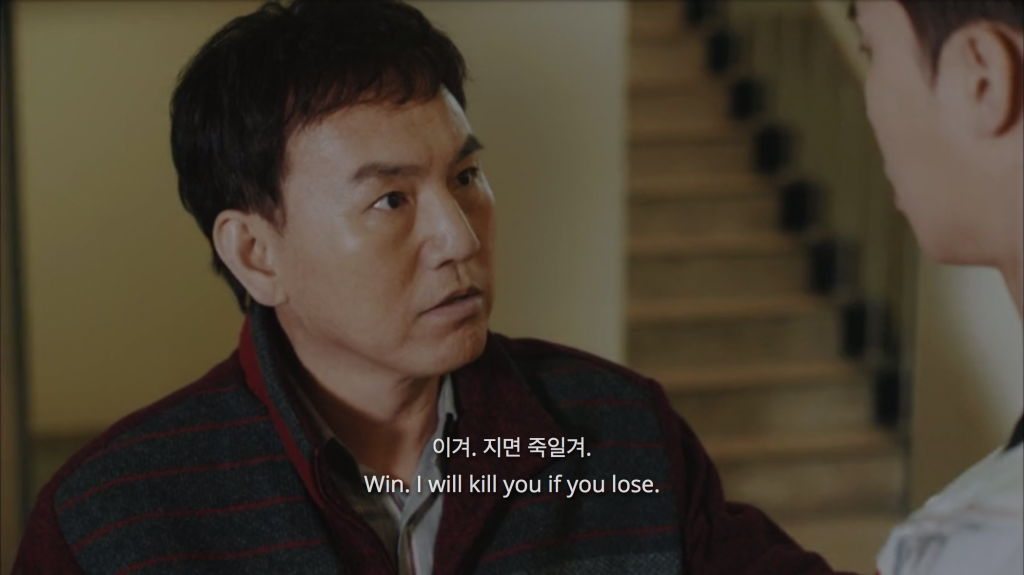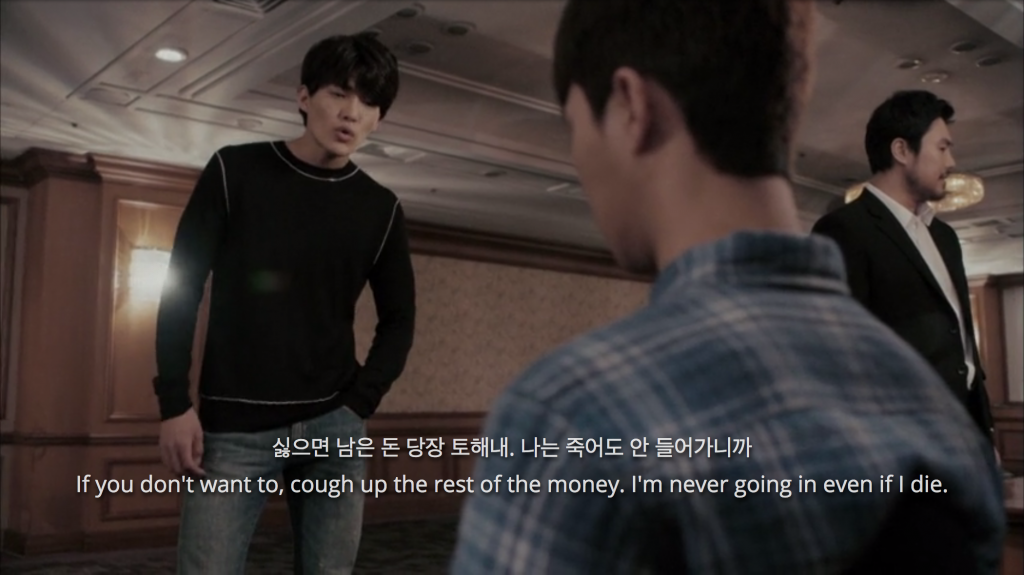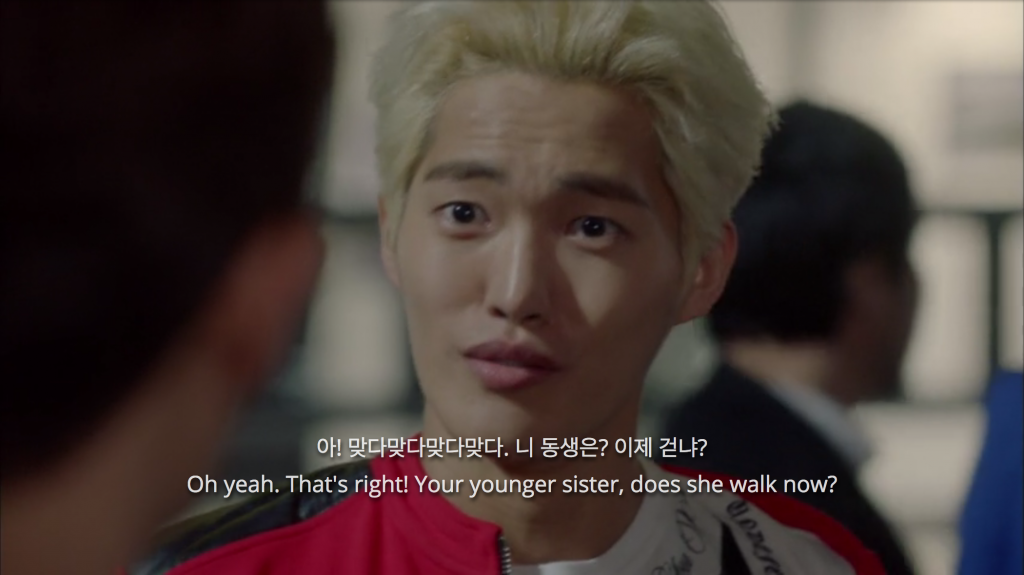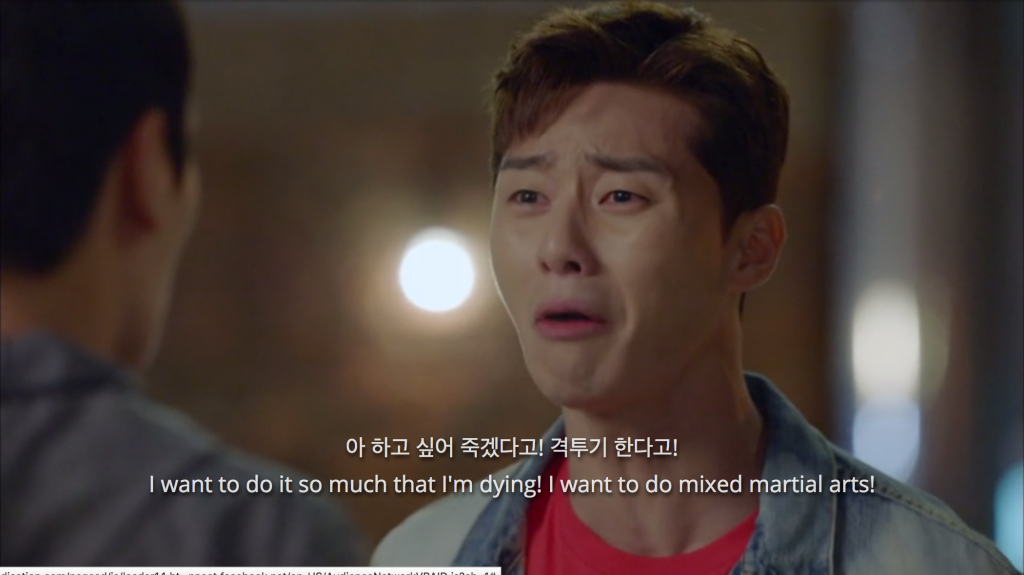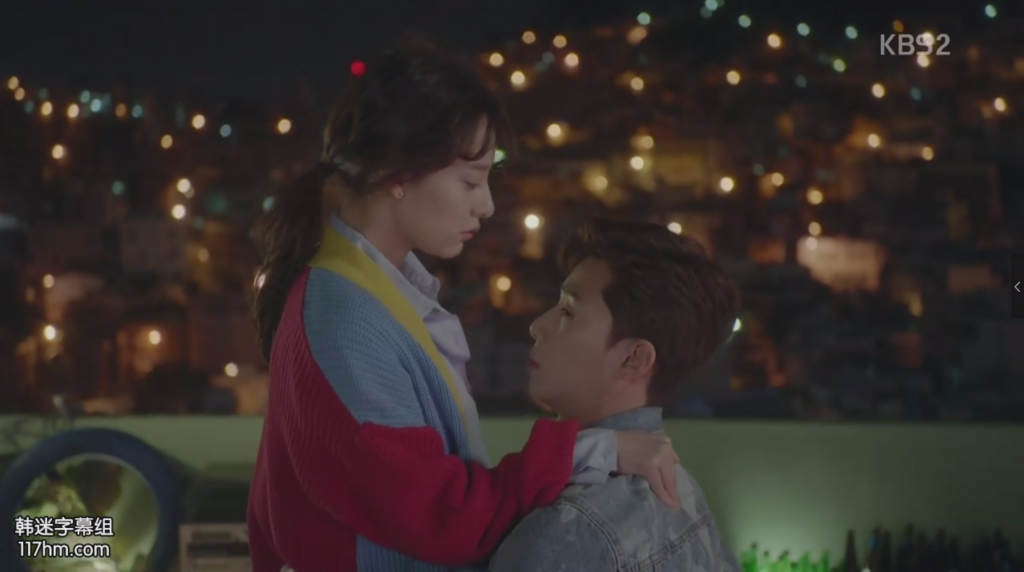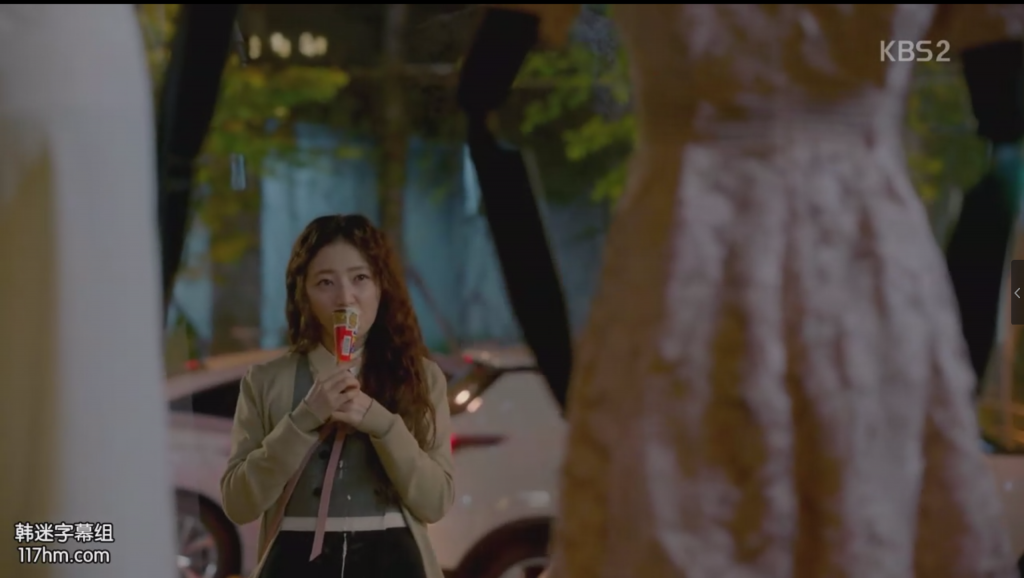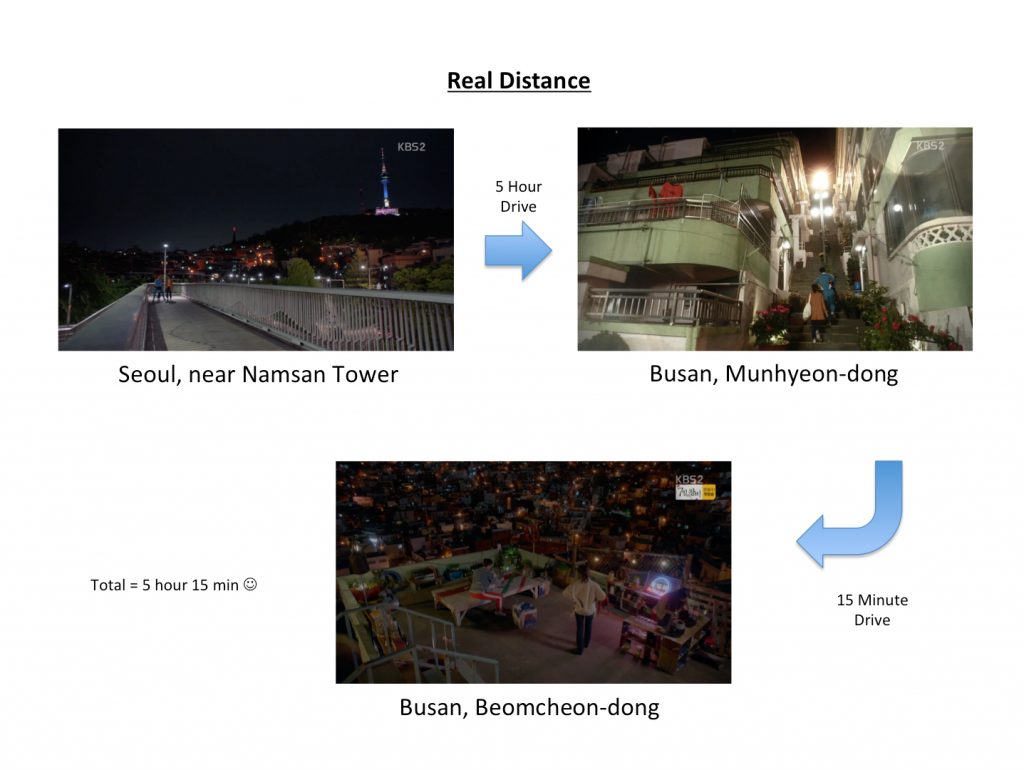Introduction
In recent years, there is a cultural diffusion known as the “Hallyu” that the popular culture of South Korea (e.g., television drama, pop music, movies, fashion, and celebrities) has become increasingly popular in worldwide, especially in East, South, and Southeast Asia (Shim 2008). As one of the significant components in “Hallyu,” Korean drama (K-drama) had been studied by many scholars over issues like gender stereotypes, politics, marriage, education, employment, etc (Chan and Wang 2011, Cho 2017, Lee and Park 2015, Lee 2013, Prieler, Ivanov, Hagiwara 2015, Yang 2008, Wall 2016). However, romantic comedy seemed to be neglected by scholarly discourse, and the types of love stories that have always broadcasted on national television networks like KBS, MBC, and SBS, along with the reason why people both inside and outside of Korea are so attracted to those love stories were rarely examined (Wall 2016: 74). K-drama typically present a scenario that both leading characters express strong (sometimes even unrealistic) mutual love and desire toward each other by overcoming difficulties such as social status (e.g., Boys over Flower), time (e.g., My Love From the Star), horrible accident (e.g., Winter Sonata), and so on (Miyose 2015, Wall 2016). There is a genre which commonly represents in K-drama, that is, the “Cinderella” theme. I use the example of Fight for My Way(2017) to argue that K-drama viewers are no longer eager to watch unrealistic romance about “Cinderella” who represent women as feminine subjects by placing them in the domestic role, are abused by jealous women and require their ultimate rescue by male figures. Rather, K-drama viewers are more willing to watch a “sassy girl” who is independent and hard-working to pursuing her dream (usually professional job) and sometimes adapt protective role for the male leading character. However, I claim that “sassy girl” is another product of male design which assimilates women to accept a role that seemingly empowers women but again perpetuate narrow role of women as a proper “lady” or wife and mother. Thus, I compare the portrayal of the romance comedy from 2004 to 2017 to explain why “sassy girl” is just another way to acculturate women to an acceptable role in patriarchal society by explicitly examining two K-drama: My Name Is Kim Sam-soon (2004) and Fight for My Way (2017). Finally, I further explain the gender stereotype by examining the interpersonal relationship between female main characters and female peripheral characters in Fight for My Way.
The current study is critical because the gender representation in television can potentially affect society and limit women’s opportunities. Previous research provides two theories to explain the significance of media effect, that is, social cognitive theory and cultivation theory (Prieler, Ivanov, Hagiwara 2015). The social cognitive theory (Bandura 2009) explained that people learn social behaviour through direct and vicarious observation, such as watching television. Gender-specific behaviours can be acquired through a model in both real life and television (fiction world). Cultivation theory (Gerbner 1988) claims that the longer people watch television, the heavier the ideological message transmitted from television influences how people perceive the real world. Romantic comedy among every other genre of K-drama needs much more attention than it acquired. Because such drama targeted to the population from 10s to 30s, the young generation will be unconsciously influenced by the standards of female role and potentially limited their choices to be an independent soul other than somebody’s wife and mother in the future (Lee and Park 2015). Moreover, with the popularity of the romantic comedy, the range of influential widespread to most countries in Asia, and few countries in other continents. The similarity of cultural background not only attract more audiences from other countries in Asia but also has a more profound impact on them, primarily female viewers (Chan and Wang 2011, Yang 2008).
The Collapse of Cinderella Theme
The tale of Cinderella is one of the most popular bedtime stories that has been spread from centuries ago till now, yet its highly recognizable plot continues to be a popular contemporary: a girl who was suffered and treated maliciously by her stepmother and stepsisters (women) but eventually reverse her fate into a regal existence by marrying a prince charming (men) (Lutz 1999: 1-2). The tale can be divided into five elements: 1) a girl who suffered from the negative influence due to her lowly status, 2) the occurrence of magic which alters the position of the girl briefly, 3) the Prince Charming who is wealthy and successful with high social status, 4) the “Prince Charming” who fall in love with the girl in the first sight, 5) the glass shoes which symbolized the cosmically predestined love between the girl and the Prince Charming, and 6) marriage, which represent “happily ever after”. Such tale subversively represents and impart a sclerotic patriarchal message that not only meets the criteria of sociocultural value but also correspond to gender stereotype in South Korea. For example, Boys over Flower is a typical Cinderella story that Geum Jan-di, the female leading character who suffered undeserved discrimination or neglect due to her lowly social status suddenly lifted fortuitously by making the “Prince Charming” Gu Jun-pyo fell in love with her and has been protected by him ever since. However, such Cinderella-themed romance was not appealing to audiences both inside and outside Korea anymore, and many K-drama viewers and feminists began to criticize it because of its patriarchal message (Chan and Wang 2011).
In Fight for My Way, a romantic comedy premiered in the spring of 2017, and soon was praised for its realistic plot. The first few episodes of Fight for My Way portrayed the “loser” image of four main characters: Ko Dong-man, Choi Ae-ra, Kim Joo-man, and Baek Seol-hee. Their life used to be full of sparks and possibilities when they were young. But at the current time in the drama, their life was considered as “three level,” and none of them fulfilled their dream. The scriptwriter and director openly criticize the unrealistic and deception of Cinderella theme and acclaim independent women who work hard and succeed on their own. Although Ae-ra can be considered as the “Cinderella” who broke up with her boyfriend because he had cheated on her by having a sexual relationship with a wealthy, middle-aged woman, her childhood friend Dong-man can hardly considered as a “Prince Charming” due to his marginal career and slender income. As the same as Ae-ra, Dong-man was a “loser,” who had negligible occupations, painful and unsuccessful romantic relationship experiences, lack of belongingness in Seoul, and was stagnant in the crossroad of his life. To further illustrate their point, scriptwriter and director shape the character called Park Moo-bin, a successful doctor who fell in love with Ae-ra. The story of Moo-bin and Ae-ra have all of the elements to form Cinderella theme:
1) Ae-ra as the “Cinderella.”
2) the magical moment when she was invited to pretend to be a famous announcer from Hong Kong for her friend’s wedding. There is also the BGM of Bibbidi-Bobbidi-Boo, originally from the cartoon Cinderella, showing the change of Ae-ra from a poor department store employee to a famous and professional announcer.
3) Moo-bin, as the “Prince Charming” and also the standard male character who is supposed to compete for the female leading character with the male leading character, he presented as innocent, gentle, and highly positioned as a wealthy doctor.
4) Moo-bin seemingly fell in love with Ae-ra. He courted her by buying her many luxury gifts, and planning date events involved spending money.
And 5) Moo-bin also bought a pair of expensive shoes that stand for glass shoes for Ae-ra, although those are not her size, which foreshadowing that Cinderella love story is not suitable for Ae-ra.
However, with Moo-bin’s confession, the scriptwriter and director tear the veil of prince charming and reveal the chauvinist pigs characteristic underneath. Not only he already had a Japanese fiancee, but also he wanted to keep Ae-ra around as his mistress even after he married with his fiancee. The monologue of Ae-ra says that compared to Cinderella, the brat who sell lies to little girls, the Zhangfei of Three Kingdom (i.e., a military general in the late Eastern Han dynasty and early Three Kingdom period) is much sexier. Such plot design overturn the stereotype of romantic K-drama, such as female leading character as the Cinderella-type girl who is kind and carry the financial burden of family and herself with millions of part-time jobs, and also the prince-like male character (whether leading or not; such as the Yoo Min-hyuk in Full House) who is not only handsome but also rich and smart. Moreover, the scriptwriter and director also wanted to portray an image of “sassy girl”, that is, an independent and hard-working modern female who is responsible for herself. The interlude of Ae-ra and Moo-bin is a turning point of Ae-ra and Dong-man’s relationship, but it’s also an appealing plot for K-drama viewers because many viewers from Korea and other countries began to question domestic role and showed an increasing preference for strong female role that defy social norm. Furthermore, with the emergence of Western culture, K-drama viewers can no longer identify themselves with the female role portrayed in K-drama. For example, some viewers in Singapore who are ethnic Chinese described that even though the values that shaped in the K-drama were not alien to them, they do not adapt some traditional values (e.g., a female should marry a male in an early adulthood, place domestic responsibility as wife and mother in priority, and in deference to elderly and husband, etc.) in the real life anymore (Chan and Wang 2011: 296-297). The transformation of gender role and the impact of Western value led K-drama viewers expect new portrayals of women along with the new types of romantic comedy recently, that is, the “sassy girl.”
The Rise of “Sassy Girl”
The term “sassy girl” originally comes from the My Sassy Girl (2001), a movie sweep from Asia to North America, and received a great success in both Eastern and Western society (Park 2010:5). The film brought a popular trend in Korea as well as other East Asian countries, for example, although male viewers still appreciate conservative girlfriend in real life, young people in contemporary China generally welcome female’s aggressive behaviour as a new kind of flirting styles or a mode of communication in a dating relationship (Wang and Ho 2007: 628). Despite the general acceptance of both female and male viewers, researchers criticize the female’s aggressive behaviour as either an inappropriate product of extreme feminism or a way to promote the traditional value of masculinity and femininity (林 2013: 59, 刘 2015: 113, Wang and Ho 2007: 628-629). The (re)construction of traditional masculinity and femininity involved three aspects (Park 2010: 6-9). Firstly, feminizing male leading character (Gyeon-woo) as a “mama’s boy” aspect of Korean masculinity which foreshadowing his emasculating relationship with the female leading character (the Girl) at the beginning of the film. Second, emphasizing the Girl’s aggressive, unfeminine behaviour and alcoholism. The chronic drinking behaviour is essential here because drinking is regarded as a “male activity” in Korea. Although Korean society is experiencing a rapid increase in alcohol consumption among women, the factors (e.g., marital status) that reduce the quantity or frequency of drinking for females are not affecting males (Chung and Yoon 2013: 389). Finally, through love, both Gyeon-woo and the Girl reconstruct their masculinity and femininity to be a proper “gentleman” and “lady.” The “sassy girl” image and the pattern of romance also happened in My Name is Kim Sam-soon and Fight for My Way, which I will compare and explain why the pattern of the romantic story evolved over time but the gender stereotype immobilized during this period.
My Name Is Kim Sam-soon (2004) is a romantic comedy about a chubby girl called Kim Sam-soon, who worked as a pastry chef. Regardless her plump appearance which not fit into beauty standard in Korean society, she still won the heart of the male leading character (Hyun Jin-hyeon) by expressing her “sassy” personality. My Name Is Kim Nam-soon received good reputation for promoting gender equality since Sam-soon was a strong female character who represent independent women who have their own career rather than domestic women after marriage (Chan and Wang 2011: 301). However, the pattern of plot and the characteristics of female leading characters may change, the messages it delivered are still similar to traditional gender roles. For example, Sam-soon’s boyfriend broke up with Sam-soon because Sam-soon discovered his infidelity, she begged him to stay rather than confronted him bravely or leave him resolutely. She even thought about committed suicide, so turning a ghost may help her revenge her ex-boyfriend. Moreover, her “sassy” personality is an expression of self-defense mechanism that is only triggered by Jin-hyeon, her ex, and her female rivals. However, when she encountered gender inequality or discrimination in the workplace, she often displays compliance and obedience, particularly toward male elderly. Although it is reasonable if considering the traditional value of Korean society, such inconsistency in personality raise questions toward the scriptwriter and director’s purpose of shaping Sam-soon’s characteristics. Furthermore, Sam-soon’s career is a pastry chef, which may link to female’s domestic role: a woman’s responsibility to cook food for her husband and children. Finally, when Sam-soon failed her job interview, the turning point for her was throwing her homemade cake on boss’s face (Jin-hyeon). Apparently, Sam-soon had special talents on pastry which good enough to won the boss’s heart, who just got punched by the cake in front of every employee. With Jin-hyeon help, Sam-soon got her job as a pastry chef in Jin-hyeon’s restaurant. And she constantly caused trouble but all sorted out by Jin-hyeon. Then he married her in the end of the drama. My Name Is Kim Sam-soon can be considered as a classic Cinderella themed romance, include Jin-hyeon as the “Prince Charming” lifted “Cinderella” Sam-soon’s position by helping her career and marrying her.
Compare to My Name Is Kim Sam-soon, Fight for My Way (2017) has a different male role and a distinct pattern of romantic comedy, but the portrayals of female leading characters are similar to each other. Choi Ae-ra, a “sassy girl” that is akin to Sam-soon, she had a dream that is to be a television announcer. In spite of the elimination of Cinderella theme, gender stereotype exists in this drama as well. For example, although she bravely broke up with her ex-boyfriend who had a sexual relationship with a wealthy middle-aged woman and also dumped Moo-bin who lied her about his intention of courting her, her aggressive behaviours in most of the time only acted as a self-defense mechanism that protecting her pride instead of showing her “woman power.” Besides, although the leading male character (Ko Dong-man) was initially as poor as Ae-ra, he eventually achieved success in his MMA career and inspired Ae-ra to build her own career. It is a typical gender stereotype that male has to be more successful and dominant than female (Miyose 2015: 12). Dong-man was, like Gyeon-woo, in an “abused” relationship with Ae-ra who, like the Girl, forced Dong-man to do what she wanted him to do and act aggressively toward him in both verbal and nonverbal way. But as long as they confirmed their romantic relationship, their position reversed involved Dong-man act dominantly such as forcing Ae-ra to change her dress because her slender legs are attracting to other men on the street. Ae-ra, on the other hand, became obedience and compliance (inwardly) toward Dong-man. In addition, Ae-ra’s dream job was an announcer, but she always got discriminated from female job interviewer because of her lack of experience and poor education. In the end, she got her job from MMA arena by male job interviewer which again indicate the savior or heroic role of male characters compared to evil and snobbish female characters. Finally, the drama is about how male and female leading characters tried to pursue their dream, but the drama focuses on Dong-man’s journey to be an MMA fighter more than Ae-ra’s journey to be an announcer. The drama put more effort on Ae-ra’s romantic relationship with different kinds of men and her complex familial connection.
Both My Name Is Kim Sam-soon and Fight for My Way include the career-focused female role, but the seemingly independent female leading characters all raise the same problem: it seems that both scriptwriters and directors currently try to express different kinds of female characters in contrast to stereotypes of female characters in the past, but they failed to maintain the balance between stereotypes and anti-stereotypes of female characters. Such problems not only exist in leading characters but also in peripheral characters.
Stereotypes vs. Anti-stereotypes of Female Characters
Choi Ae-ra vs. Park Hye-ran. Lee (2013: 172-173) demonstrates that the structure of gender relations and the culture of confucianism acts as constraints that limited female’s opportunities and specific experiences in higher education (e.g., Bachelor Degree, M.D, Ph.D) and labor market. Also, Lee and Park (2015: 394) state that gender inequality index (GII) announced in 2011 that women in South Korea scored relatively high in reproductive health (maternal mortality and adolescent fertility) and educational attainment of empowerment, but fair in labor market and particularly low in parliamentary representation of empowerment. Even though the rate of women’s labor market participation (50%) is relatively low compared to men’s labor market participation (73%), the women’s labor market participation rate is generally increasing in recent years. According to the fact that women in 20s have higher employment rate (63%) than women in 30s (56%), the major obstacles in women’s continued professional career development from women in 20s to 30s are marriage and potential child-rearing responsibilities (Lee and Park 2015: 395). In response to the above information, a few women who were shown with paid work in the drama were mostly young singles in low-paying job. Moreover, Lee and Park claim that dramas sometimes portraying women who worked in professional careers usually are occupations that were consistent with the traditional notion of femininity such as television show host or “depicting women as protagonists who pursued their dream by overcoming obstacles placed by their personal circumstances and social traditions” (2015: 396). Furthermore, Lee and Park also discover that the rate of women in managerial positions were lower than men in dramas broadcasted during 2002-2004, and women in managerial positions were more likely to be major road blockers and (tried to) harm the kind and innocent female leading character than men in managerial positions. Furthermore, the findings of Lee and Park’s study present that females are more valued if they are highly attractive and still in youth rather than their social and professional accomplishments. Park Hye-ran, an famous announcer who divorced from a wealthy family, again represent an example of Cinderella theme’s failure. She was not only the Ae-ra’s rival in love but also her rival in workplace. The drama presented that Hye-ran was constantly in Ae-ra’s way toward her dream job and love from college to current time in the drama. Moreover, her successful career as an announcer caused numerous inconveniences for Ae-ra. Furthermore, the job interviewers who criticize Ae-ra were all women. It is problematic for the drama to emphasis on such women-verses-women gender stereotype. Because in real life, the conflict and difficulties in competition in labor market also exist between women and men and usually discrimination came from men (Gress and Paek 2014, Jung, Kim, and Ahn 2014, Kim and William 2012). However, in the end of the movie, Hye-ran seemed suddenly moved by Ae-ra’s kindness, started to build friendship with Ae-ra. On the contrary to the previous idea that bad people would always be bad, the change of Hye-ran indicate the anti-stereotypes of female characters. But such change is too rigid to accept by viewers.
Choi Ae-ra vs. Baek Seol-hee. It is interesting that many K-drama viewers in China favoured Baek Seol-hee1, the female second-leading character who dreamed to be a wife and mother had a boyfriend who was also Dong-man’s high school friend called Kim Joo-man for six years. In opposite to Ae-ra, Seol-hee is typical girl who fit into the traditional notion of femininity, as well as her dream, that is, to be a mother and a wife. Her world was all about Joo-man until she broke up with him because of the possibility of Joo-man’s infidelity. She used to look dependent and indecisive due to her the lack of courage to speak the truth in the public and the lack of ability to manage the threat (Ye-jin, a girl who had crush on Joo-man). However, the way she broke up with Joo-man in a decisive manner after finding out he might cheat on her and confrontation with Ye-jin showed her independence as a strong woman. The strength that was elicited from a suppose-to-be-weak image of Seol-hee made the drama looked more interesting. Some K-drama viewers left comments that criticize the plot line of Ae-ra and Dong-man and praise the plot line of Seol-hee and Dong-man1:
“Are they really belong to three class? The male leading character had a beautiful and successful ex-girlfriend and a skilled coach who was willing to sacrifice everything just to see him return to MMA arena, and he had been worked as a lowly positioned employee for ten years but were able to win his first fight with professional MMA fighter. The female leading character was very attractive and were able to act as a wedding host and later on an MMA arena host, although she had been worked as a receptionist department store for ten years. They are actually belong to first class.”
“I love Seol-hee and Joo-man, their story is more realistic than Dong-man and Ae-ra’s. Both Dong-man and Ae-ra had their special talents for their dream, whereas Joo-man and Seol-hee are not that lucky, just two ordinary people who struggled in several issues such as job promotion, marriage, house, and family like other ordinary people in real life.”
Seol-hee is a success example of anti-stereotype of female characters. Seol-hee’s story, compared to Ae-ra’s, is more realistic. Seol-hee and Ae-ra, as childhood friends, lived in the same apartment, having the same type of lifestyle, the same socioeconomic status, and the same education background. Seol-hee had no special talent, she achieved what she have now by hard-working and down-to-earth dedication. Although her effort may not grantee what she want, she was heading to her goal step by step. The image of Seol-hee reflects real self which means who a person actually is, whereas Ae-ra reflects ideal self that is how people want to be, an idealized image that include components of parents’ expectations, individual preference, and social norm. Without unrealistic complex familial connections or love interests from different kinds of males, her difficulties came from the temptation Joo-man faced and future mother/sister-in-law, which K-drama viewers can identify themselves with. Therefore, instead of trying to find something new against stereotypes of female characters, portray female characters as what K-drama viewers can identify with seems much better.
Conclusion
K-drama has lack of variety in portrayal of female leading characters and type of romantic relationships. Even though the awareness of such issue and the public demand prompt the latest K-drama (e.g., Fight for My Way) develop new kinds of romantic relationship, it is still critical for drama producers and scriptwriters to find a balance between stereotypes of female lead and anti-stereotypes and how to avoid undermining the anti-stereotype characters.
References:
Bandura, A. Social cognitive theory of mass communication. In Media effects: Advances in theory and research, edited by J. Bryant & M. B. Oliver (Eds.), 94-124. New York: Routledge, 2009.
Chan, Brenda and Wang Xueli. “Of Prince Charming and Male Chauvinist Pigs: Singaporean Female Viewers and the Dream-world of Korean Television Dramas.” International Journal of Cultural Studies, no. 3 (2011): 291-305.
Cho, Michelle. “Domestic Hallyu: K-Pop Metatexts and the Media’s Self-Reflexive Gesture.” International Journal of Communication, no. 11 (2017): 2308-2331
Chung, Sulki and Yoon Hong Sik. “Drinking: Another glass ceiling? Social drinking andalcohol use among women in Korea.” International Journal of Social Welfare, no. 4 (2014): 384–39.
Gerbner, G. Cultivation analysis: An overview. Mass Communication & Society, no. 1 (1988): 175-194.
Gress, Douglas P. and Paek Jeeyon. “Differential Spaces in Korean Places? Feminist Geography and Female Managers in South Korea.” Gender, Work, and Organization, no. 2 (2014): 165–186.
Jung, Hae-Sik, Kim Soo-Wan and Ahn Sang-Hoon. “Multidimensional Inequality in South Korea: An Empirical Analysis.” Asian Social Work and Policy Review, no. 8 (2014):170-191.
Kim, Seung-sup and David R. William. “Perceived Discrimination and Self-Rated Health in South Korea: A Nationally Representative Survey.” PLoS One, no. 1 (2012): 1-9.
Lee, Jiyeun and Park Sung-yeon. “Women’s Employment and Professional Empowerment in South Korean Dramas: a 10-year analysis.” Asian Journal of Communication, no. 4 (2015): 393-404.
Lee, Sunghoe. “Gender, Power and Emotion: Towards Holistic Understanding of Mature Students in South korea.” Gender and Education, no. 2 (2013): 170-188.
林, 鹭萍. “解析情节剧中男权主导话语的重建 ——— 以韩国电影《我的野蛮女友》为例.” 外国电影评论, no. 17 (2013): 58-59.
刘, 丹. “‘野蛮’背后《: 我的野蛮女友》探析.” 绥化学院学报, no. 6 (2015): 111-114.
Lutz, Rosemary. Cinderella’s Social Transformation. New York: University of South Florida Press, 1999.
Miyose, Colby Y. Unrealistic Weeds of Love and Romance: The Korean Drama and the “Flower Boy” Genre. UNLV Theses, Dissertations, Professional Papers, and Capstones, 2015.
Park, Jane Chi Hyun. “Remaking the Korean Romcom: A Case Study of Yeopgijeogin Geunyeo and My Sassy Girl.” In Complicated Currents: Media Flows, Soft Power and East Asia, edited by Daniel Black, Stephen Epstein, Alison Tokita, 1-12. Melbourne: Monash University, 2010.
Prieler, Michael, Alex Ivanov and Shigeru Hagiwara. “Gender Representations in East Asian advertising: Hong Kong, Japan and South Korea.” Communication & Society, no. 1 (2015): 27-41.
“三流之路短评,” 豆瓣. https://movie.douban.com/subject/26972688/ (Assessed Nov.22, 2017)
Shim, Doobo. “The Growth of Korean Cultural Industries and the Korean Wave.” In East Asia Pop Culture: Analysing the Korean Wave, edited by Chua Beng Huat and Koichi
Iwabuchi, 15-31. Hong Kong: Hong Kong University Press, 2008.
Wall, Barbara. “Self-mockery of Hallyu in the Korean Drama My Love from the Star (Byeoleso on geudae) and the Role of the Seventeenth-century Novel The Dream of the Nine Clouds (Guunmong).” Journal of Japanese and Korean Cinema, no. 1 (2016): 73-87.
Wang, Xiying and Ho Petula Sik Ying. “My Sassy Girl: A Qualitative Study of Women’s Aggression in Dating Relationships in Beijing.” Journal of Interpersonal Violence, no. 5 (2007): 623-638.
Yang, Fang-chih Irene. “Engaging with Korean Dramas: Discourses of Gender, Media, and Class Formation in Taiwan.” Asian Journal of Communication, no. 1 (2008): 64-79.


